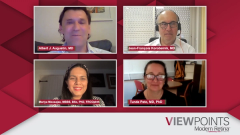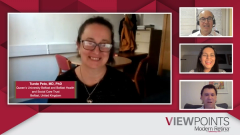
Optimizing Care For Patients With Retinal Disorders
Key takeaways from a discussion on the management of age-related macular degeneration, diabetic macular edema, and inherited retinal disease and insight regarding what to look forward to as the field advances.
Episodes in this series

Albert J. Augustin, MD: Before we conclude, I would like to get some final thoughts from all of you. Let’s start with Dr Korobelnik. Can you say a few words on the future of dry AMD [age-related macular degeneration]?
Jean-Franҫois Korobelnik, MD: We have seen a lot of research activities for new long-duration treatments in wet AMD and in diabetic retinopathy. There is also a lot of research and developments for advanced dry AMD, for geographic atrophy, and there are currently 2 ongoing phase 3 trials from 2 companies that are looking at inhibition of the complement cascade. We should know later in 2021, or in 2022, [whether] those drugs are beneficial to slow down the progression of the disease. If it works, this will be interesting because it’s a completely unmet need [right now]. We’ll see.
Albert J. Augustin, MD: Thank you. So it’s all about inflammation at this time?
Jean-Franҫois Korobelnik, MD: Yes.
Albert J. Augustin, MD: Dr Moosajee, do you have some concluding remarks?
Mariya Moosajee, MBBS, BSc, PhD, FRCOphth: I am truly excited by my field. For the first time in our careers, we can now say that there is an approved gene therapy available for patients with inherited retinal disorders, with a wealth of trials to follow up. I would like to see more genes being covered, and that, at the moment, is still a very costly process, so maybe it’s targeting more common pathways. There are gene therapies that are being developed towards a factor called rod-derived cone viability factor, which essentially helps cones to uptake glucose and to convert that into energy and work better. Hopefully that kind of universal treatment will be able to be accessed by more patients with inherited retinal disorders rather than on a gene-based system. It is a promising field and we will learn a lot from the work that is being done in AMD and diabetic retinopathy, in terms of the devices that you’re using and trialing now, and how we can apply that to our field.
Albert J. Augustin, MD: Thank you. Dr Peto, some words from your side?
Tunde Peto, MD, PhD: I completely agree that we live in an exciting era of diagnostics and treatment. Something we’ve learned from the pandemic is that patients adapt very well to the new environment. We are now seeing patients over the age of 90 who will happily have a virtual consultation with us. We are seeing people who are using home monitoring devices, and we’re also seeing patients who happily come to virtual clinics where they spend very little time, get images quickly, and then only come back to a busy clinic if they need injections or treatment. We need to learn from these developments, we need to cherish them and go on with providing the best service because this helps us to strategize and restratify our clinics and get everyone to the right clinical pathway.
Albert J. Augustin, MD: Do you think this digital world will reduce the quality? Five years ago we all spoke about multimodal imaging, high-quality images, and combining images from different modalities, just to be more secure and do more sophisticated diagnostics. Now everything is digital. We do images with devices at home, which don’t have the quality as compared with devices in a big hospital, and you can’t combine different images. Do you think the quality will go down a little bit?
Tunde Peto, MD, PhD: What we need to do is to make sure that the quality of those images that we get supplied with go up. When they started the anti-VEGF [vascular endothelial growth factor] injections, we didn’t have SD OCTs [spectral domain optical coherence tomography], we had time domain OCTs. As soon as more people used them, more people needed to have an OCT, and more people needed more details—suddenly the price dropped, and a lot of new functions appeared. I’m hoping that the home monitoring devices will undergo the same type of development. We must remember that, in a lot of patients, we only need to decide if they need to come in or not, and if they need an injection or not. So we might not need every single time and every bit of imaging that we usually do at diagnosis. If we’re clever about it and we get good images, then we might be able to change the dynamic of a clinic to those who are higher risk.
Jean-Franҫois Korobelnik, MD: We must differentiate between initial visit baseline to make the diagnosis, then we need multimodality and follow-up. For follow-up, OCT probably does it all. So home monitoring with OCT can be promising. We don’t need multimodality on each visit.
Tunde Peto, MD, PhD: I think that’s why we call it monitoring, because, for diagnostics, you need to get the diagnosis right. They can have all sorts of other diseases that mimic AMD, and old patients with diabetes can have a lot of other diseases as well. We need to establish a secure diagnosis, especially if we don’t see them regularly in the clinic.
Albert J. Augustin, MD: Thanks to all of you and to our viewing audience. We hope you found this Modern Retina-Ophthalmology Times Europe Viewpoints discussion to be rich and informative. Thank you very much.
Transcript edited for clarity.
Newsletter
Get the essential updates shaping the future of pharma manufacturing and compliance—subscribe today to Pharmaceutical Technology and never miss a breakthrough.



















































